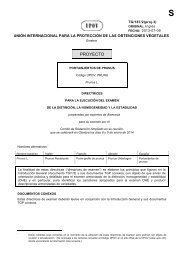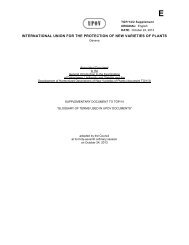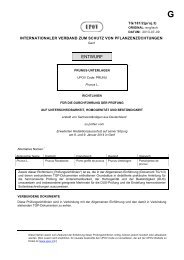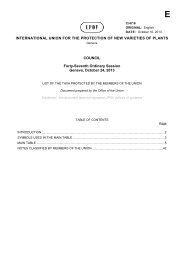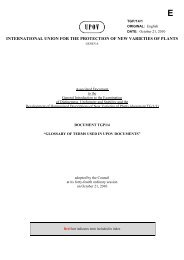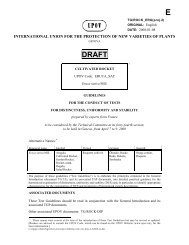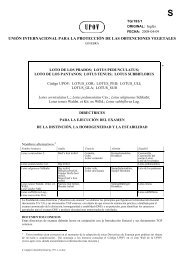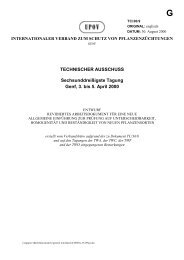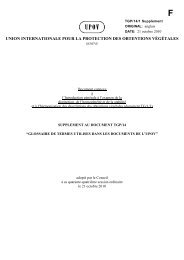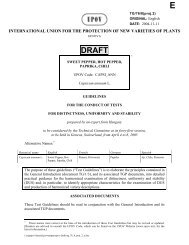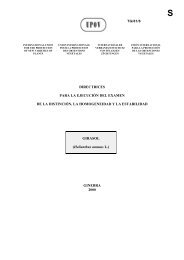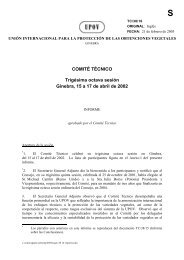(Pleurotus ostreatus (Jacq.) P. Kumm.) - International Union for the ...
(Pleurotus ostreatus (Jacq.) P. Kumm.) - International Union for the ...
(Pleurotus ostreatus (Jacq.) P. Kumm.) - International Union for the ...
Create successful ePaper yourself
Turn your PDF publications into a flip-book with our unique Google optimized e-Paper software.
TG/PLEUR(proj.5)<br />
Oyster Mushroom, 2013-02-11<br />
- 4 -<br />
4. Assessment of Distinctness, Uni<strong>for</strong>mity and Stability<br />
4.1 Distinctness<br />
4.1.1 General Recommendations<br />
It is of particular importance <strong>for</strong> users of <strong>the</strong>se Test Guidelines to consult <strong>the</strong> General Introduction<br />
prior to making decisions regarding distinctness. However, <strong>the</strong> following points are provided <strong>for</strong> elaboration<br />
or emphasis in <strong>the</strong>se Test Guidelines.<br />
4.1.2 Consistent Differences<br />
The differences observed between varieties may be so clear that more than one growing cycle is not<br />
necessary. In addition, in some circumstances, <strong>the</strong> influence of <strong>the</strong> environment is not such that more than a<br />
single growing cycle is required to provide assurance that <strong>the</strong> differences observed between varieties are<br />
sufficiently consistent. One means of ensuring that a difference in a characteristic, observed in a growing<br />
trial, is sufficiently consistent is to examine <strong>the</strong> characteristic in at least two independent growing cycles.<br />
4.1.3 Clear Differences<br />
Determining whe<strong>the</strong>r a difference between two varieties is clear depends on many factors, and<br />
should consider, in particular, <strong>the</strong> type of expression of <strong>the</strong> characteristic being examined, i.e. whe<strong>the</strong>r it is<br />
expressed in a qualitative, quantitative, or pseudo-qualitative manner. There<strong>for</strong>e, it is important that users of<br />
<strong>the</strong>se Test Guidelines are familiar with <strong>the</strong> recommendations contained in <strong>the</strong> General Introduction prior to<br />
making decisions regarding distinctness.<br />
4.1.4 Number of Fruit Bodies / Parts of Fruit Bodies to be Examined<br />
Unless o<strong>the</strong>rwise indicated, <strong>for</strong> <strong>the</strong> purposes of distinctness, all observations on single fruit bodies<br />
should be made on 90 fruit bodies or parts taken from each of 90 fruit bodies and any o<strong>the</strong>r observations<br />
made on all fruit bodies in <strong>the</strong> test, disregarding any off-type fruit bodies.<br />
4.1.5 Method of Observation<br />
The recommended method of observing <strong>the</strong> characteristic <strong>for</strong> <strong>the</strong> purposes of distinctness is<br />
indicated by <strong>the</strong> following key in <strong>the</strong> second column of <strong>the</strong> Table of Characteristics (see document TGP/9<br />
“Examining Distinctness”, Section 4 “Observation of characteristics”):<br />
MG: single measurement of a group of fruit bodies or parts of fruit bodies<br />
MS: measurement of a number of individual fruit bodies or parts of fruit bodies<br />
VG: visual assessment by a single observation of a group of fruit bodies or parts of fruit bodies<br />
VS: visual assessment by observation of individual fruit bodies or parts of fruit bodies<br />
Type of observation: visual (V) or measurement (M)<br />
“Visual” observation (V) is an observation made on <strong>the</strong> basis of <strong>the</strong> expert’s judgment. For <strong>the</strong><br />
purposes of this document, “visual” observation refers to <strong>the</strong> sensory observations of <strong>the</strong> experts<br />
and, <strong>the</strong>re<strong>for</strong>e, also includes smell, taste and touch. Visual observation includes observations<br />
where <strong>the</strong> expert uses reference points (e.g. diagrams, example varieties, side-by-side<br />
comparison) or non-linear charts (e.g. color charts). Measurement (M) is an objective<br />
observation against a calibrated, linear scale e.g. using a ruler, weighing scales, colorimeter,<br />
dates, counts, etc.<br />
Type of record: <strong>for</strong> a group of plants (G) or <strong>for</strong> single, individual plants (S)<br />
For <strong>the</strong> purposes of distinctness, observations may be recorded as a single record <strong>for</strong> a group of<br />
plants or parts of plants (G), or may be recorded as records <strong>for</strong> a number of single, individual<br />
plants or parts of plants (S). In most cases, “G” provides a single record per variety and it is not<br />
possible or necessary to apply statistical methods in a plant-by-plant analysis <strong>for</strong> <strong>the</strong> assessment<br />
of distinctness.”



